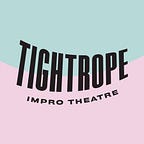All the World is (an Outdoor) Stage
by Jeff Gladstone
An audience of strangers on the street is the most honest audience you could ask for. When the audience is bored, they LEAVE. On television, if you’re bored you can just change the channel. In indoor theatre, if you’re bored, you suffer in silence.
Woven into many of the improv exercises and games we know and love, is the principle that if the scene is suffering, or if the actors are struggling, you can stop! People sometimes call it “disposable theatre” but more accurately, it’s an art form that is intimately connected with the audience. The objective is to compel them to stay with engaging and entertaining theatre.
When I was learning improvisation at the Loose Moose Theatre Company (the theatre company in Calgary Alberta where Theatresports, Maestro & Gorilla were created by Keith Johnstone), it was 1994. The first Theatresports shows were performed in 1977, so at that time, improv as we know it today was just coming of age.
Before that, Keith Johnstone had begun developing the ideas that became famous in his book IMPRO while teaching at the Royal Court Theatre in London, and touring the streets with his group Theatre Machine, as far back as the 1950s. They toured all over Europe with these public improvisation shows, and most of the time to non-english speaking audiences. So, it’s no coincidence that improvisation has an international appeal, and the foundations of street performance are buried in the theories and games we all love.
The common practise with contemporary street performing is to make a big finale that the audience won’t want to miss, often including chainsaws, a giant unicycle, fire, and audience volunteers. The trick is to have a promised finale worth staying for, and stretching out the tension so that your audience grows as you get closer. When the big finale is pulled off, the crowd will scatter, but hopefully you’ve earned enough loyal fans to want to leave $5 in your hat before running off.
Of course street performing goes back even further. In Shakespeare’s time, groups like the King’s Men would have to make their money touring the provinces, especially during plague times. They would have to gather an audience, create some sort of performance area out of boxes and set pieces (that would have to fit in a few carriages) and keep the audience’s attention before they got pulled away by the cries of a bear engaged in a vicious bear baiting spectacle. In fact in London Bear Baiting was such a popular event, that they built open-air stadiums throughout the city. Theatre troupes, if they were lucky, could rent out the bear baiting arenas on off-nights to perform the latest hit play, like The Life and Death of King Henry the Sixth.
In Italy, groups of Commedia del Arte performers would roam the streets performing for passersby. They developed things like the “Slap Stick” — a red stick that would make a loud crack — to add panache to the fights and brawls in the Commedia scenarios. They used masks to create heightened and engaging characters. Likely, most of what they did in the streets was improvised, playing with whatever person or animal they happened to come across. At some point, they started writing down the scenarios. Very soon after that, these performances stopped. Coincidence? Keith believes it was the act of writing them down, then learning them by rote, is what caused them to fall off of public appeal. They had ceased to be responsive to their audience.
Going back another 1000 years to Ancient Greece, the original theatres were all outdoors. It seems obvious that they were built outdoors, because there was already a tradition of performing stories and songs outside. They used Masks so that the heightened characters could reach the back row, and they trained their voices (one story has an actor rehearsing their lines with rocks in their mouths in order to practise articulation) to reach the audience and compel them to follow the story. Music and singing were also used, the fact the term “Chorus” was the name of the group who would sing the narration of a tale, while a single actor would play out the emotions of the story.
Contemporary theatre, film and television has moved further and further away from responsiveness, following agreed upon rules of storytelling and narrative, assuming that by following the rules, they will tell good stories. Street theatre shows us that a good story is one that compels the audience to come closer, to lean in, to care; things you only know by becoming an expert at watching your audience, and being able to change what’s happening if you feel their attention drifting. Highly responsive entertainment.
So, when we look at performing improvisation (or any theatre) outside, we must look at these components:
- How will you draw a crowd? What techniques will you use to get their initial buy-in?
2. How can you reach the widest audience possible, do you need some sound amplification, or can you make up for that with energy (and clarity).
3. How will you watch and attune to your audience?
4. What is your “finale” and how will you ramp up to it in a way that holds your audience’s attention?
5. Are you prepared to make changes on the fly? If a scene or game isn’t holding your audience, do you have adaptations or alternatives you can move to seamlessly?
6. What other surprises can you use to keep the audience on their toes?
7. How can you create a sense of danger and risk?
8. What are the ways you can involve your audience?
10. Will you collect money after? What are your plans to do so efficiently and effectively.
Check out Jeff’s Impro Street Theatre class, June 19th + 20th.
Register at www.tightropetheatre.com/impro-street-theatre
